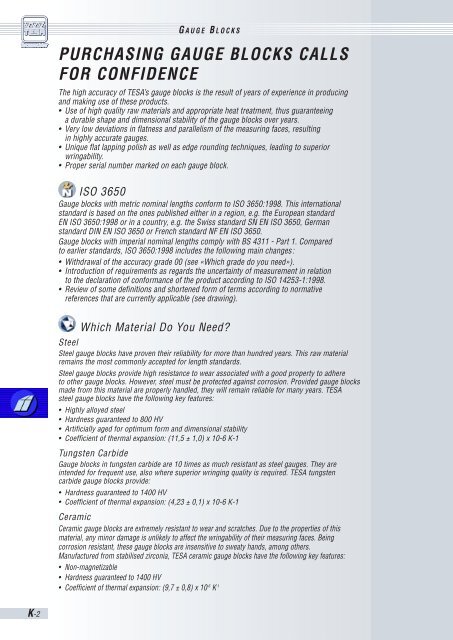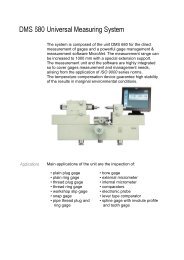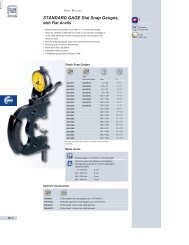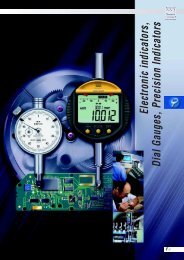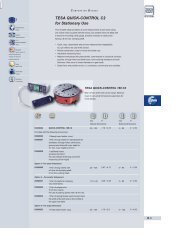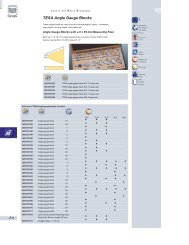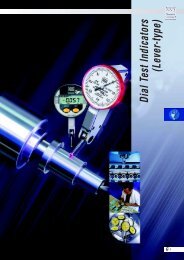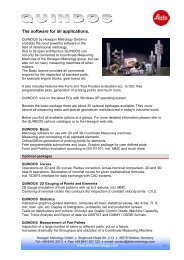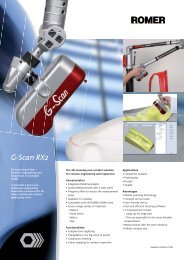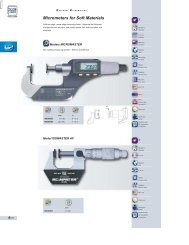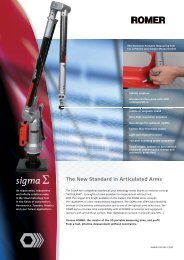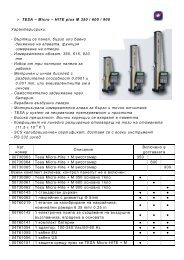Length and Angle Standards
Length and Angle Standards
Length and Angle Standards
- No tags were found...
You also want an ePaper? Increase the reach of your titles
YUMPU automatically turns print PDFs into web optimized ePapers that Google loves.
G A U G E B L O C K SPURCHASING GAUGE BLOCKS CALLSFOR CONFIDENCEThe high accuracy of TESA’s gauge blocks is the result of years of experience in producing<strong>and</strong> making use of these products.• Use of high quality raw materials <strong>and</strong> appropriate heat treatment, thus guaranteeinga durable shape <strong>and</strong> dimensional stability of the gauge blocks over years.• Very low deviations in flatness <strong>and</strong> parallelism of the measuring faces, resultingin highly accurate gauges.• Unique flat lapping polish as well as edge rounding techniques, leading to superiorwringability.• Proper serial number marked on each gauge block.ISO 3650Gauge blocks with metric nominal lengths conform to ISO 3650:1998. This internationalst<strong>and</strong>ard is based on the ones published either in a region, e.g. the European st<strong>and</strong>ardEN ISO 3650:1998 or in a country, e.g. the Swiss st<strong>and</strong>ard SN EN ISO 3650, Germanst<strong>and</strong>ard DIN EN ISO 3650 or French st<strong>and</strong>ard NF EN ISO 3650.Gauge blocks with imperial nominal lengths comply with BS 4311 - Part 1. Comparedto earlier st<strong>and</strong>ards, ISO 3650:1998 includes the following main changes:• Withdrawal of the accuracy grade 00 (see «Which grade do you need»).• Introduction of requirements as regards the uncertainty of measurement in relationto the declaration of conformance of the product according to ISO 14253-1:1998.• Review of some definitions <strong>and</strong> shortened form of terms according to normativereferences that are currently applicable (see drawing).Which Material Do You Need?SteelSteel gauge blocks have proven their reliability for more than hundred years. This raw materialremains the most commonly accepted for length st<strong>and</strong>ards.Steel gauge blocks provide high resistance to wear associated with a good property to adhereto other gauge blocks. However, steel must be protected against corrosion. Provided gauge blocksmade from this material are properly h<strong>and</strong>led, they will remain reliable for many years. TESAsteel gauge blocks have the following key features:• Highly alloyed steel• Hardness guaranteed to 800 HV• Artificially aged for optimum form <strong>and</strong> dimensional stability• Coefficient of thermal expansion: (11,5 ± 1,0) x 10-6 K-1Tungsten CarbideGauge blocks in tungsten carbide are 10 times as much resistant as steel gauges. They areintended for frequent use, also where superior wringing quality is required. TESA tungstencarbide gauge blocks provide:• Hardness guaranteed to 1400 HV• Coefficient of thermal expansion: (4,23 ± 0,1) x 10-6 K-1CeramicCeramic gauge blocks are extremely resistant to wear <strong>and</strong> scratches. Due to the properties of thismaterial, any minor damage is unlikely to affect the wringability of their meas uring faces. Beingcorrosion resistant, these gauge blocks are insensitive to sweaty h<strong>and</strong>s, among others.Manufactured from stabilised zirconia, TESA ceramic gauge blocks have the following key features:• Non-magnetizable• Hardness guaranteed to 1400 HV• Coefficient of thermal expansion: (9,7 ± 0,8) x 10 -6 K -1K-2 K-2


